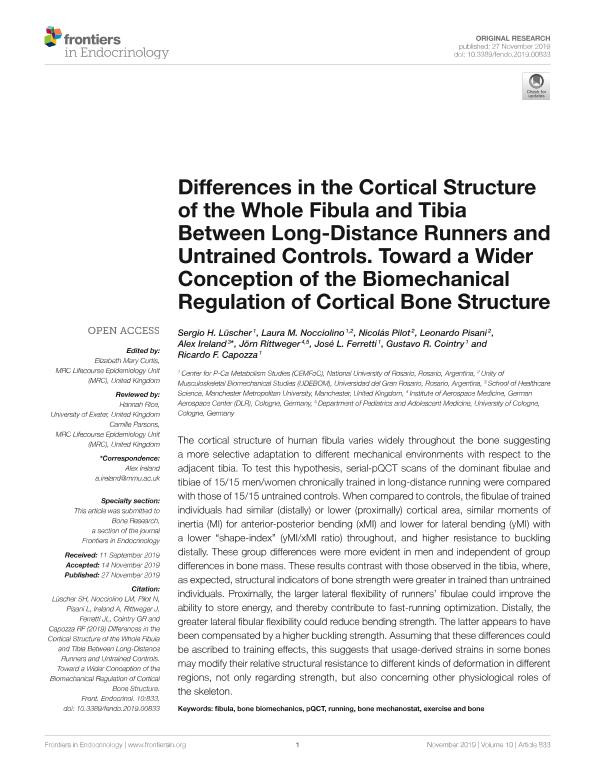Mostrar el registro sencillo del ítem
dc.contributor.author
Luscher, Sergio Hugo

dc.contributor.author
Nocciolino, Laura Marcela

dc.contributor.author
Pilot, Nicolas Carlos

dc.contributor.author
Pisani, Leonardo
dc.contributor.author
Ireland, Alex

dc.contributor.author
Rittweger, Jörn
dc.contributor.author
Ferretti, Jose Luis

dc.contributor.author
Cointry, Gustavo Roberto

dc.contributor.author
Capozza, Ricardo Francisco

dc.date.available
2022-01-25T12:46:42Z
dc.date.issued
2019-11
dc.identifier.citation
Luscher, Sergio Hugo; Nocciolino, Laura Marcela; Pilot, Nicolas Carlos; Pisani, Leonardo; Ireland, Alex; et al.; Differences in the Cortical Structure of the Whole Fibula and Tibia Between Long-Distance Runners and Untrained Controls: Toward a Wider Conception of the Biomechanical Regulation of Cortical Bone Structure; Frontiers Media; Frontiers in Endocrinology; 10; 11-2019; 1-13
dc.identifier.uri
http://hdl.handle.net/11336/150604
dc.description.abstract
The cortical structure of human fibula varies widely throughout the bone suggesting a more selective adaptation to different mechanical environments with respect to the adjacent tibia. To test this hypothesis, serial-pQCT scans of the dominant fibulae and tibiae of 15/15 men/women chronically trained in long-distance running were compared with those of 15/15 untrained controls. When compared to controls, the fibulae of trained individuals had similar (distally) or lower (proximally) cortical area, similar moments of inertia (MI) for anterior-posterior bending (xMI) and lower for lateral bending (yMI) with a lower “shape-index” (yMI/xMI ratio) throughout, and higher resistance to buckling distally. These group differences were more evident in men and independent of group differences in bone mass. These results contrast with those observed in the tibia, where, as expected, structural indicators of bone strength were greater in trained than untrained individuals. Proximally, the larger lateral flexibility of runners' fibulae could improve the ability to store energy, and thereby contribute to fast-running optimization. Distally, the greater lateral fibular flexibility could reduce bending strength. The latter appears to have been compensated by a higher buckling strength. Assuming that these differences could be ascribed to training effects, this suggests that usage-derived strains in some bones may modify their relative structural resistance to different kinds of deformation in different regions, not only regarding strength, but also concerning other physiological roles of the skeleton.
dc.format
application/pdf
dc.language.iso
eng
dc.publisher
Frontiers Media

dc.rights
info:eu-repo/semantics/openAccess
dc.rights.uri
https://creativecommons.org/licenses/by/2.5/ar/
dc.subject
PQCT
dc.subject
FIBULA
dc.subject
BONE MECHANOSTAT
dc.subject
RUNNERS
dc.subject
CORTICAL BONE
dc.subject
BONE GEOMETRY
dc.subject
DINAMOMETRY
dc.subject
BONE BIOMECHANICS
dc.subject.classification
Otras Ciencias de la Salud

dc.subject.classification
Ciencias de la Salud

dc.subject.classification
CIENCIAS MÉDICAS Y DE LA SALUD

dc.title
Differences in the Cortical Structure of the Whole Fibula and Tibia Between Long-Distance Runners and Untrained Controls: Toward a Wider Conception of the Biomechanical Regulation of Cortical Bone Structure
dc.type
info:eu-repo/semantics/article
dc.type
info:ar-repo/semantics/artículo
dc.type
info:eu-repo/semantics/publishedVersion
dc.date.updated
2020-11-27T18:46:58Z
dc.identifier.eissn
1664-2392
dc.journal.volume
10
dc.journal.pagination
1-13
dc.journal.pais
Suiza

dc.journal.ciudad
Lausana
dc.description.fil
Fil: Luscher, Sergio Hugo. Universidad Nacional de Rosario. Facultad de Ciencias Médicas. Centro de Estudios de Metabolismo Fosfocálcico; Argentina
dc.description.fil
Fil: Nocciolino, Laura Marcela. Consejo Nacional de Investigaciones Científicas y Técnicas. Centro Científico Tecnológico Conicet - Rosario; Argentina. Universidad Nacional de Rosario. Facultad de Ciencias Médicas. Centro de Estudios de Metabolismo Fosfocálcico; Argentina
dc.description.fil
Fil: Pilot, Nicolas Carlos. Universidad Nacional de Rosario. Facultad de Ciencias Médicas. Centro de Estudios de Metabolismo Fosfocálcico; Argentina
dc.description.fil
Fil: Pisani, Leonardo. Universidad Nacional de Rosario. Facultad de Ciencias Médicas. Centro de Estudios de Metabolismo Fosfocálcico; Argentina
dc.description.fil
Fil: Ireland, Alex. Manchester Metropolitan University; Reino Unido
dc.description.fil
Fil: Rittweger, Jörn. Centro Aero Espacial Aleman; Alemania. Universitat zu Köln; Alemania
dc.description.fil
Fil: Ferretti, Jose Luis. Consejo Nacional de Investigaciones Científicas y Técnicas. Centro Científico Tecnológico Conicet - Rosario; Argentina. Universidad Nacional de Rosario. Facultad de Ciencias Médicas. Centro de Estudios de Metabolismo Fosfocálcico; Argentina
dc.description.fil
Fil: Cointry, Gustavo Roberto. Consejo Nacional de Investigaciones Científicas y Técnicas. Centro Científico Tecnológico Conicet - Rosario; Argentina. Universidad Nacional de Rosario. Facultad de Ciencias Médicas. Centro de Estudios de Metabolismo Fosfocálcico; Argentina
dc.description.fil
Fil: Capozza, Ricardo Francisco. Consejo Nacional de Investigaciones Científicas y Técnicas. Centro Científico Tecnológico Conicet - Rosario; Argentina. Universidad Nacional de Rosario. Facultad de Ciencias Médicas. Centro de Estudios de Metabolismo Fosfocálcico; Argentina
dc.journal.title
Frontiers in Endocrinology
dc.relation.alternativeid
info:eu-repo/semantics/altIdentifier/url/https://www.frontiersin.org/article/10.3389/fendo.2019.00833/full
dc.relation.alternativeid
info:eu-repo/semantics/altIdentifier/doi/http://dx.doi.org/10.3389/fendo.2019.00833
Archivos asociados
